AC Generator: An Introduction
Imagine you have a smartphone and your smartphone is about to be discharged and you are notified that electrical authorities are gonna be a power cut for 3 days in your locality due to a major short circuit in the transformer.
After listening to this news, how do you feel? Maybe you become sad. You may feel sad because You can’t able to charge your phone during these three days’ intervals. For today’s generation electricity become a lifeline. Without electricity, peoples start feeling bored and they feel that they miss something.
But have you ever thought about where this electricity came from? How does it produce? Electricity is produced by several means, some are listed below –
- Hydroelectric power plant – by rotating turbines
- Geological heat
- Windmills
- Nuclear Power plant
- DC Generators
- AC Generators
- Burning of coal etc.
You will have seen that when the electricity goes, peoples start Generators to fulfill the requirement of electricity. So have you thought about what are these Generators? How does its work? If you didn’t think about then don’t worry. Today we are going to talk about AC generators in detail.
What is an AC generator?
AC Generator is a machine also called Alternators is a machine that converts mechanical energy into electrical energy by rotating the coil in a magnetic field by some external force. It works on the principle of electromagnetic induction, which involves rotating a wire coil inside a magnetic field to generate an electrical voltage. AC Generator is a famous electricity-producing machine all over the world. And it is far far better than DC Generator.
Types of AC Generators
Alternators, or AC Generators, are electrical machines that convert mechanical energy into electrical energy. AC generators are categorized into several types, including:
- AC Generators: AC generator, also known as an alternator, is an electrical machine that converts mechanical energy into electrical energy in the form of alternating current (AC).
- DC Generators: DC generator is an electrical machine that converts mechanical energy into electrical energy in the form of direct current (DC). It operates on the principle of electromagnetic induction and consists of a stator and a rotor.
- Synchronous generators: These generators have a fixed number of poles and rotate at a constant rate. They are frequently used in power plants and for large-scale power generation.
- Induction generators: They are also known as asynchronous generators and are commonly found in small-scale wind turbines and other renewable energy systems. They generate electricity without the use of a permanent magnet or excitation.
- Brushless generators: These generators have a permanent magnet rotor and a stator that is controlled by an electronic system. They are frequently used in automotive applications as well as portable generators.
- Homopolar generators have a single pole and generate direct current (DC) rather than alternating current (AC) (AC). They’re frequently used in high-power applications like particle accelerators.
- Doubly-fed generators have two windings on their rotor and can control their output voltage and frequency. They are frequently used in windmills and hydroelectric power plants.
- Variable frequency generators can change their frequency to match the frequency of the load they’re powering. They’re frequently used in applications like aviation and military systems.
Difference between AC and DC generator
The basic difference between AC and DC generators are given below:
| Parameters | AC Generator | DC Generator |
| Output Power | It generates AC electric power | It produces DC electric power |
| Rings | They have slip-rings. | They have split-ring commutators. |
| Current induction | Its output current can be induced either in the rotor or in the stator | Its output current is induced in the rotor only |
| Direction of Current | Electrical current reverses direction periodically. | Electrical current flows only in one direction. |
| Commutators | AC generator does not have commutators. | DC generators have commutators due to which the current flow only in one direction. |
| Distribution and Transmission | The distribution of the output is easy. | It is difficult to distribute the output. |
| Efficiency | AC generators are very efficient as the energy losses are less. | Due to sparking and other losses like copper, eddy current, mechanical, and hysteresis losses DC generators are less efficient. |
| Maintenance | Requires very less | It requires frequent maintenance |
| Direction of Current | In an AC generator, the electrical current reverses direction periodically. | The electrical current flows only in one direction. |
| Types | Rotating armature, Rotating field Single-phase, Three-phase | Permanent magnet, Separately-excited, Self-excited |
| Voltage Distribution | Transformers are used to distribute AC voltage. | Transformers are not used to distribute DC voltage. |
| Voltage Level | They are useful to generate very high voltages | They are used to generate lower voltages |
Working principle of AC generator class 12
Working principle of AC generators: It works on the principle of electromagnetic induction, which says that whenever a magnetic flux linked with the coil changes, an EMF is induced in the coil and this induced EMF gives the induced current in the coil. And the phenomenon by which EMF is induced in the coil by changing the magnetic flux linked to the closed circuit is called electromagnetic induction.
Construction & diagram of an AC Generator
The construction of an AC Generator is not very complicated, anyone can make AC Generator at home, but it is necessary that the person know some elementary knowledge of electromagnetism. Here you can see the basic construction of the AC Generator.
Parts of an AC generator
The main basic parts of an AC Generator are –
- Two permanent magnets
- Soft iron core
- Armature coil
- Slip rings
- Brushes
- Prime mover
Now let’s talk about their functions in detail –
Two permanent magnets
This is a very very important part of an AC Generator. You can’t imagine an AC Generator without these magnets. This magnet is curved in shape and attached to the wall of the stator (A stator is the stationary part of the AC Generator in which the armature coil rotates). The main purpose of these two permanent magnets is to create a magnetic field.
Soft iron core
A soft iron core is a material that protects and supports the coil. The binding of coils is done on this soft iron core. It is done because a soft iron core can concentrate the magnetic field as much as 50,000 times more intensely than an air core. So it is used to increase the strength of the magnetic field.
Armature coil
It is the coil of copper that is bound to the soft iron core. A soft iron core with copper coiling forms an armature of cylindrical shape which rotates in between the stator and cut magnetic field lines. This armature coil is also called the rotor. Due to magnetic flux change induced EMF and current formed in this coil.
Slip rings
These are hollow rings that are connected to the endpoint of the armature coil. Slip rings are the point of transmission of induced current through the brushes to the external electrical equipment. It is insulated from the inside and fixed on the axle or shaft and it helps in the smooth rotation of the armature or rotor.
Brushes
Brushes are made up of stationary graphite and metal contact (brush). It is connected to the slip rings and used for collecting the induced current from it. When the armature rotates in between the stator then slip rings also rotate and when slip rings rotate these brushes rub on its outer curved surface and collect the induced current.
Prime mover
A Prime mover is an external machine having a diesel or kerosene tank, which is used for rotating the rotor (armature coil) in the stator. This prime mover can be diesel engines or electric motors. When the prime mover starts, it creates a very loud noisy sound.
Working of an AC generator class 12
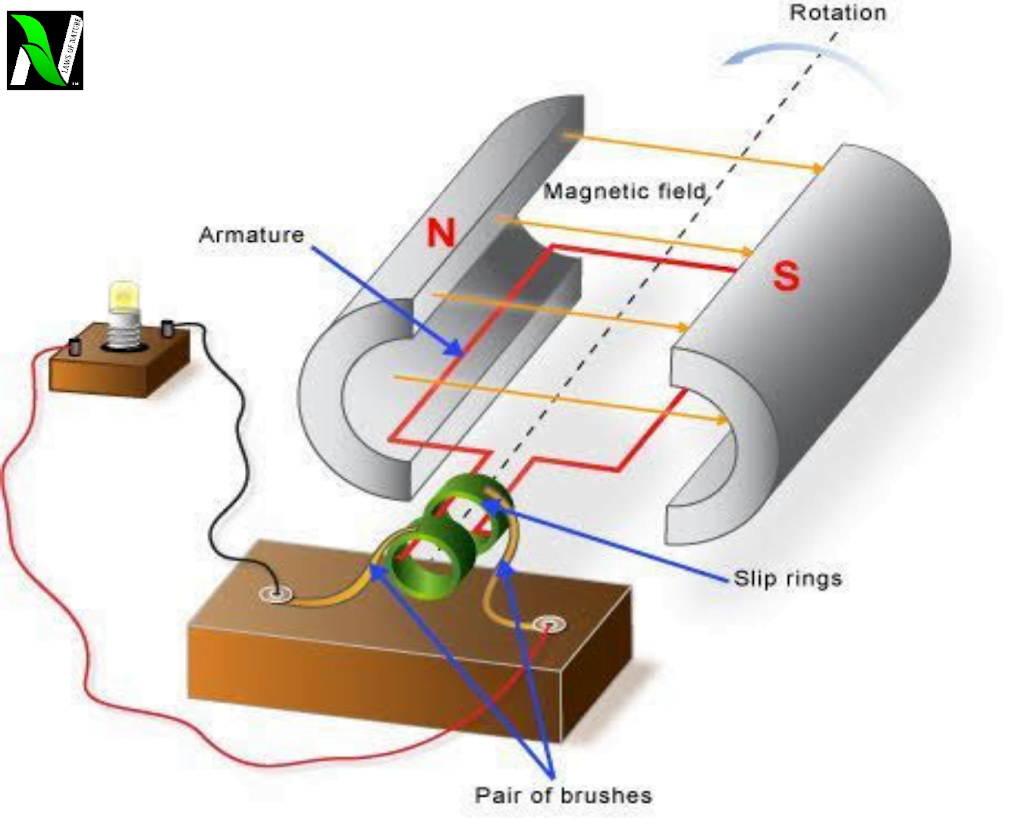
Now let’s understand the working of the AC Generator, basically, the AC Generator works on the principles of Michael Faraday’s laws of electromagnetic induction.
When the armature coil or rotor rotates in the magnetic field by the external machine like diesel engines or electric motors. The magnetic flux linked to the coil changes continuously. This continuously changing magnetic flux in the coil give the induced current or EMF. And this induced current is transmitted by the slip rings through the brushes to run the electronic machines.
This induced current is formed due to the changing magnetic flux linked to the coil, if a current is formed due to changing of magnetic flux then the current is also changing, it means changing magnetic flux induced only the changing current, and this changing current is called alternating current. Then we can say that any currents which are formed due to the process of electromagnetic induction are alternating currents.
In an AC generator, a wire coil rotates within a magnetic field. A magnetic field is typically generated by a set of stationary magnets or an electromagnet. The magnetic field passing through the coil changes as it rotates, inducing a voltage in the wire. This voltage creates an alternating current (AC) in the wire, which can be used to power electrical devices.
Watch this video for more understanding.
Derivation of induced EMF and current in AC Generator
According to the Michael Faraday laws of electromagnetic induction. Whenever the amount of magnetic flux linked to the circuit changes an EMF is induced in the circuit. Mathematically, it is given as – $$\mathcal{E}= = -\frac{d\phi}{dt}$$ If $N$ is the number of turns in the coil then – $$\mathcal{E} = -N\frac{d\phi}{dt}\qquad ….(1)$$ Magnetic flux $(\phi)$ is given as $$\phi = B.A = BA\cos\theta \qquad…(2)$$ Put the value of $\phi$ in equation …(1) $$\mathcal{E} = -N\frac{d}{dt}(BA\cos\theta)\qquad…(3)$$ Here, θ is the angular displacement of the rotor, and it is given as the product of angular velocity and time. $$\theta = \omega t$$
Put the value of θ in equation …..(3) $$\begin{aligned} \mathcal{E}& =-N\frac{d}{dt}(BA\cos\omega t)\\ & = -NBA\frac{d}{dt}(cos\omega t)\\& = NBA\omega \sin\omega t\\ \mathcal{E}& = \mathcal{E}_0\sin \omega t \end{aligned}$$ where $\mathcal{E}_0 = NBA\omega$ , called peak alternating voltage. Thus, $\displaystyle{\mathcal{E} = NBA\omega \sin\omega t}$ is the induced EMF in the armature coil. If $R$ is the resistance of the coil, then current is given as $$I = \frac{\mathcal{E}}{R}$$ Or $$I = \left(\frac{NBA\omega}{R}\right)\sin\omega t$$ $\displaystyle{I = I_0\sin\omega t}$, where $\displaystyle{I_0 = \frac{NBA\omega}{R}}$ called peak alternating current.
On what factors amount of induced EMF depends on
The amount of voltage induced in an AC generator’s coil is determined by several factors:
- The magnetic field strength: The greater the magnetic field strength, the greater the voltage induced in the coil.
- The rotational speed of the coil: The higher the voltage induced in the coil, the faster the coil rotates.
- The number of turns in the coil: The greater the number of turns in the coil, the greater the voltage induced in the coil.
- The angle formed by the coil and the magnetic field: The amount of voltage induced in the coil can be affected by the angle at which the coil is positioned relative to the magnetic field.
- The coil size: The larger the coil, the higher the voltage induced in the coil.
It is interesting to know that we can control the output voltage and frequency of the AC generator by adjusting these factors. This is significant because various devices require different voltages and frequencies to function properly. AC generators are programmed to generate a specific voltage and frequency based on the needs of the devices they power.
Read Also:
- LC oscillation class 12
- Expression for energy and average power stored in a pure capacitor
- Expression for energy and average power stored in an inductor
Advantages and Disadvantages of AC over DC
AC (alternating current) and DC (direct current) are two types of electrical current that are used in various applications. Each type has its own advantages and disadvantages, which are as follows:
Advantages of AC over DC:
- AC is easier to generate and distribute over long distances than DC. This is because AC can be easily stepped up or stepped down using transformers, which makes it possible to transmit electricity over long distances without significant losses.
- AC is less expensive to generate than DC. AC generators are simpler and less expensive to build than DC generators.
- AC can be easily converted to DC using a rectifier. This makes it possible to use AC to power devices that require DC.
- AC motors are more efficient than DC motors. AC motors are more reliable and require less maintenance than DC motors.
Disadvantages of AC over DC:
- AC is more dangerous than DC. AC voltage can cause more severe electric shocks than DC voltage. Its peak value of AC is high $(I_0 = \sqrt{2}I_rms)$. It is very dangerous to work with AC.
- AC is more difficult to control than DC. AC voltage and frequency can fluctuate, which can cause problems with some types of devices.
- AC is less suitable for some types of applications. For example, some electronic devices require DC voltage to operate properly.
Advantages of DC over AC:
- DC is more suitable for some types of applications. For example, electronic devices require DC voltage to operate properly.
- DC is safer than AC. DC voltage is less likely to cause severe electric shocks than AC voltage.
- DC is more stable than AC. DC voltage and current are more stable than AC voltage and current.
Disadvantages of DC over AC:
- DC is more expensive to generate and distribute than AC. DC generators are more complex and expensive to build than AC generators.
- DC cannot be easily stepped up or stepped down using transformers. This makes it more difficult to transmit electricity over long distances.
- DC motors are less efficient than AC motors. DC motors require more maintenance than AC motors.
Application of AC Generators class 12
AC generators are used in a variety of industries and fields. The following are some of the most common applications for AC generators:
- Power Generation: AC generators are used to produce electricity for power grids, buildings, homes, and other facilities.
- Industrial Applications: AC generators are used to power a variety of machinery and equipment, including pumps, motors, compressors, and welding machines.
- Used in Automobiles: AC generators are used in automobiles to charge the battery, power the electrical systems, and power accessories such as lights, radios, and air conditioning systems.
- Backup power source: AC generators are used as a backup power source in the event of a power outage or an emergency.
- Renewable energy systems: AC generators are used to convert mechanical energy into electrical energy in renewable energy systems such as wind turbines, hydroelectric power plants, and solar power plants.
- Aviation and military applications: AC generators are used to power electronics, navigation systems, and other equipment in aircraft, military vehicles, and other aerospace and defense systems.
- Entertainment and events: AC generators are used in concerts, festivals, and other events to power lighting, sound systems, and other equipment.
Read Also:
- Faraday and henry’s experiments on electromagnetic induction
- Faraday’s laws of electromagnetic induction Class 12
- Electromagnetic induction | definition, applications, and history
- Transformer – Definition, Types, Working Principle, and Constructions
- Derivation for mutual inductance of two long co-axial solenoids
Frequently Asked Questions – FAQs
What is an AC generator?
AC Generator is a machine also called Alternators is a machine that converts mechanical energy into electrical energy by rotating the coil in a magnetic field by some external force.
What are AC generators used for?
AC generators convert mechanical energy into electrical energy and are used in a variety of applications such as power generation, industrial machinery, automotive systems, backup power, renewable energy systems, and entertainment events.
What is the difference between AC and DC generators?
The main difference between AC and DC generators is the type of electrical current produced. AC generators produce alternating current, which changes direction on a regular basis, whereas DC generators produce direct current, which flows in only one direction.
AC generators use slip rings and brushes to transfer power to the external circuit, whereas DC generators use a commutator. AC generators are commonly used for power generation, whereas DC generators are used for welding, battery charging, and electric vehicles.
What is the working principle of an AC generator?
It works on the principle of electromagnetic induction, which says that whenever a magnetic flux linked with the coil changes, an EMF is induced in the coil and this induced EMF gives the induced current in the coil.
What is the formula for EMF induced in the coil of the AC generator?
The formula for induced EMF in the coil of the AC generator is given as $$\mathcal{E}=NBA\omega\sin\omega t$$
Where,
$\mathcal{E}$ = EMF induced
$N$ = No. of turns of the coils
$B$ = Magnitude of magnetic field
$\omega$ = Angular velocity with which coil rotate
$t$ = Any instant of time
Stay tuned with Laws Of Nature for more useful and interesting content.

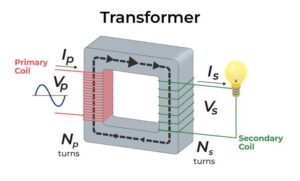
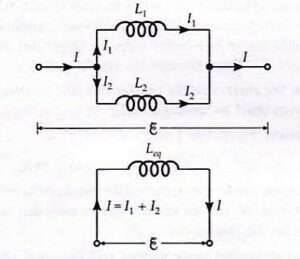
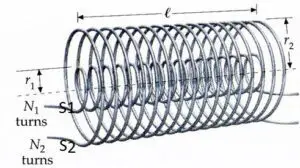
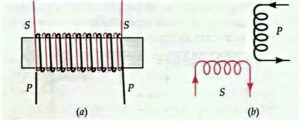
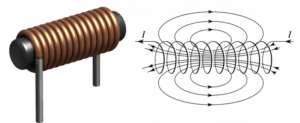
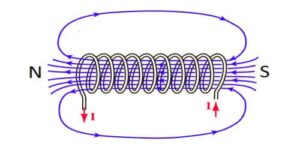
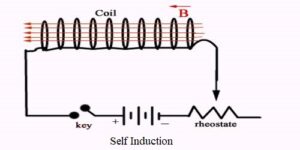

good explanation.
and complete details
Wonderful and complete explanation.